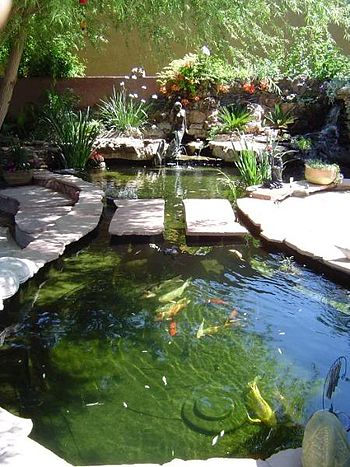 |
| English: Koi pond with an extensive filtration, built by Kent Wallace (Photo credit: Wikipedia) |
Summer is considered one of the best and more vibrant times for your Koi pond. Temperatures are beautiful, and you are more able to enjoy your pond then during the cold Winter months. However, by no means, should your maintenance drop during the summer months. Remembering a few things during the summer months will ensure that your pond stays beautiful and lively.
Higher Temperatures Cause Less Oxygen
During the summer months, the oxygen level in your pond actually decreases. Proper precautions should be taken, especially if you live in an area where temperatures stay high for the majority of the year. If you witness your Koi hanging out towards the top of the water, and they seem to be gasping for air, this may be a good indication that your pond does not have a high enough concentration of Oxygen.
One way to keep oxygen moving into your water is by installing water features such as waterfalls and fountains. The more the water is moving, the more Oxygen is available to your Koi.
If water features are not available, frequent water changes will give your fish the amount of Oxygen they need to survive.
Watch For Evaporation
Higher heat will cause your water to evaporate at a much higher rate. Pay close attention to your water levels and do adjustments as necessary. Remember, you must remove all chlorine from the water you add.
Summertime is Parasite Season
Not unlike other situations in life, heat brings on potential parasites and illness. The majority of parasites are not seeable by the naked eye, so instead, you must watch your Koi for signs of illness.
You may notice strange behaviors in your fish such as rubbing against objects, scratching, shaking, or shivering. Each symptom could indicate a different type of illness, so it is important to watch closely.
It is especially important to pay attention to your Koi if they start developing noticeable spots or changes in their body. They may also knock fins off.
If any type of change is noticed, contact your local vet, pet store, or Koi dealer as soon as possible. While some parasites will cause little damage, some illnesses such as KHV or Koi Herpes Virus have a high mortality rate and should be treated as soon as possible.
Feeding Your Koi
To remain healthy during the summer, you fish will need food high in the types of nutrients that they need. During the summer you should feed your fish a food that is low in protein at least one to three times a day. If you fish still seem hungry after feeding, you may want to increase feeding slightly.
Feeding your Koi small amounts of food at a time will prevent food from spoiling. If you feed in larger amounts, some food may remain uneaten, and it can spoil in a very short amount of time. Fish will only eat what they need to survive and will leave the rest. Spoiled food can cause water quality issues if close attention is not paid.
Feeding your Koi actually causes less Oxygen content in the water. During the summer this can especially be an issue, as Oxygen levels deplete in high temperatures. You can remedy this by feeding your fish in the cooler hours of the day.
Summer presents a special time to hand feed your Koi. Children are out of school, and the weather is usually perfect for being outside. Get the kids involved as they will remember it for years to come.

No comments:
Post a Comment